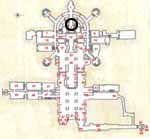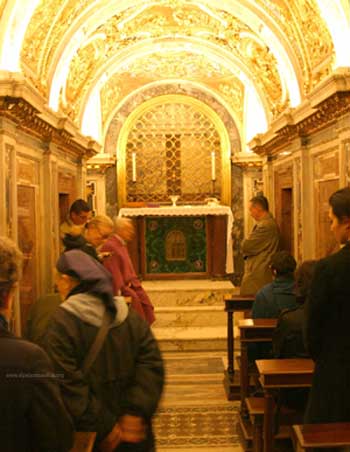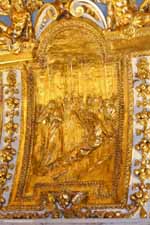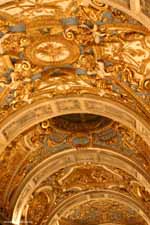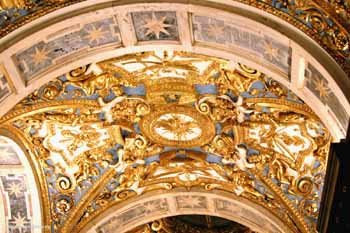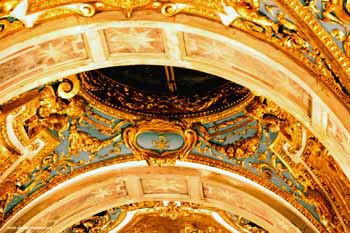|
Starting
from 1592, the ancient chapel was modified and embellished by Clement
VIII and was named Clementina. The area of the altar was enlarged
and raised. The center was prolonged toward the back and joined
to the new peribolos and, on the sides, two short sections of the
old peribolos were added and gave the chapel the shape of the upside-down
cross of Peter. The floor was lowered and a new barrel vault was
built.
In addition,
pope Clement VIII had his oratory enriched by decorating the walls
with precious marbles and gilded stuccos that can still be admired
today.
Behind the
altar, protected by a gilded bronze grid, are the remains of the
Memoria Petri, the monument built by Constantine to protect the
mortal remains of Peter. It is built of two slabs of pavonazzetto
marble separated by two porphyry strips. On top of this structure
is the base of the altar built by Calixtus II and consecrated in
1123.
Prior to the
present-day arrangement that dates from the pontificate of Pius
XII, the back of the chapel was decorated by an icon representing
Peter and Paul and reproduced in mosaic in 1879.
|
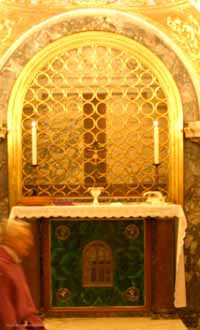
Altar in the Clementine Chapel |
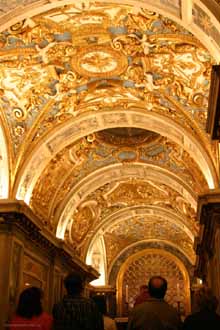
Ceiling in the Clementine Chapel |
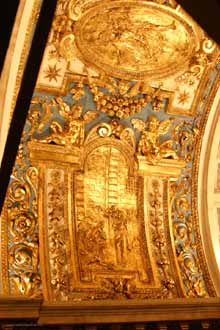 Detail
of the Gilded Ceiling
Detail
of the Gilded Ceiling |
The small altar
is located on a raised platform with 3 steps. It sits on 2 porphyry
columns and its frontal is faced with malachite affixed with four
bronze and lapis lazuli studs. Inside the facing, visible through
the opening in the front, is the original brick structure of the
altar built in the 7th century, after the construction of the crypt.
Pope Pius XII in person consecrated the altar on June 5, 1950, to
inaugurate the new layout of the chapel and the grottoes and to
crown the archeological explorations that brought to light the tomb
of the Apostle and the necropolis under the basilica.
In the lunettes
on the sides of the altar are two inscriptions. The one to the left
commemorates the brief of Benedict XIII of March 21, 1727, which
concedes to the priests celebrating Mass close to the body of Peter
the possibility to obtain plenary indulgence to free the deceased
from Purgatory. The other inscription commemorates the concession
given by Pope Gregory XVI on June 17, 1836, to celebrate Mass at
this altar in honor of St Peter at any time, except on solemn festivities.
During the
restoration, two side entrances were made to reach the archeological
remains of the Confessio. In 1952 two decorative bronze doors were
made. Both bear the crest of the Fabbrica di San Pietro and the
date of the Jubilee Year of 1950. On the left door is a quotation
from St Leo the Great, on the right door from St Hilary.
AD HANC VRBEM TV
BEATISSIME PETRE APOSTOLE
VENIRE NON METVIS
ET CONSORTE GLORIAE TVAE /
PAVLO APO(STOLO)
CONSTANTIOR QVAM CVM SVPRA MARE
GRADERERIS INGREDERIS - S. LEO PP
Oh,
Blessed Apostle Peter, you do not fear
to come to this city and with the Apostle
Paul as the companion of your glory, you
advance more firmly than when you
walked on the sea - St Leo the Great
|
BEATVS
HIC EST
QVI VLTRA HVMANVM
OCVLOS INTENDISSE ET VIDISSE
DIGNVSQVE IVDICATVS QVI
QVOD IN CHRISTO DEI ESSET
PRIMVS AGNOSCERET - S. HILARIVS
Blessed
is he who understood and saw
beyond the human sight and who was
considered worthy to be the first to know
the divinity of Christ - St Hilary
|
Some remains
of the ancient Cosmatesque marble decoration can still be seen in
the paving and in the center of the floor is a grid to provide air
to the excavations underneath. The walls are faced with precious
marbles and the dominating decorative motif is the eight-point star
from the papal crest of Clement VIII Aldobrandini. The vault is
decorated with golden stuccos on an indigo background. The ovals
and rectangles inserted between floral motifs and figures of angels
represent stories of St Peter.
Originally,
the vault was decorated with a series of bronze bas-reliefs by Ruggero
Bescape (1598-1599). They were restored by Alessandro de'Rossi (1649-1650)
and by Luigi Vanvitelli (1750) who used new stucco scenes by Giovanni
Battista Maini.
The bas-reliefs
form an iconographic study centered on the life of Peter as it is
known from the Gospels, the Acts of the Apostles, and the Apocryphal
Acts. They are presented in a random order. Starting from the side
of the altar, at the base of the little false dome, from the left
are the four scenes of: The Flogging of Peter, ordered by the Sanhedrin
after the announcement of the resurrection of Jesus (Ac 5,40-41).
To the right is The Flogging of Paul by the Jews (2 Co 11,24-25).
In front of
the altar to the left is Concordia Apostolorum, the embrace of Peter
and Paul after the dissent in Antioch (Ga 1,18); to the right is
Quo Vadis?, the encounter of Peter and Jesus on the Old Appian Way
(Apocr). In the first span from the altar is: to the left The Denial
of Peter (Jn 17,17-18); in the center: Jesus Confers the Primacy
on Peter (Jn 21,15-17); to the right: Peter Cuts off Malchus's Ear
(Jn 18,10-11).
In the preceding
span, to the left is Ananias and Sapphira at Peter's Feet (Ac 5,1-2);
to the right The Burial of the Decapitated Paul (Apocr). In the
left wing, in the oval above the marble table is Peter in front
of Nero (Apocr) while in the upper lunette is The Calling of Peter
on the Lake (Lk 5,10-11). On the small vault, to the left: The Handling
of the Keys to Peter (Mt, 16,19); to the right: Peter after the
Miraculous Draft of Fish (Lk, 5,8-9).
In the right
wing, in the oval above the marble table is St Peter on His Way
to Martyrdom (Apocr) and in the lunette above: Peter Saved by Jesus
on the Water (Mt, 14,30-31). On the small vault to the left is:
Peter Heals the Cripple (Ac, 3,6-7), to the right: Peter Heals the
Infirm (Ac, 5,15).
On the first
section of the vault, to the right from the entrance, is Peter Baptizing
Cornelius the Centurion (Ac, 10,47-48); in the center in a small
oval, is An Angel with a Palm; to the right, The Raising of Tabitha
(Ac, 9,40-41).
The original
gate of the chapel was by Simone Ponzio. The present decorative
gate in gilded bronze is the work of Ridolfo Panfili (17th century).
* * *
From 'Letters
to a Young Catholic' by George Weigel, p. 25
Leaving through the gilded baroque splendor of the Clementine Chapel,
you can't help but think that what we've just seen and touched and
smelled is about as close to the apostolic roots of the Catholic
Church as it's possible to get.
|
